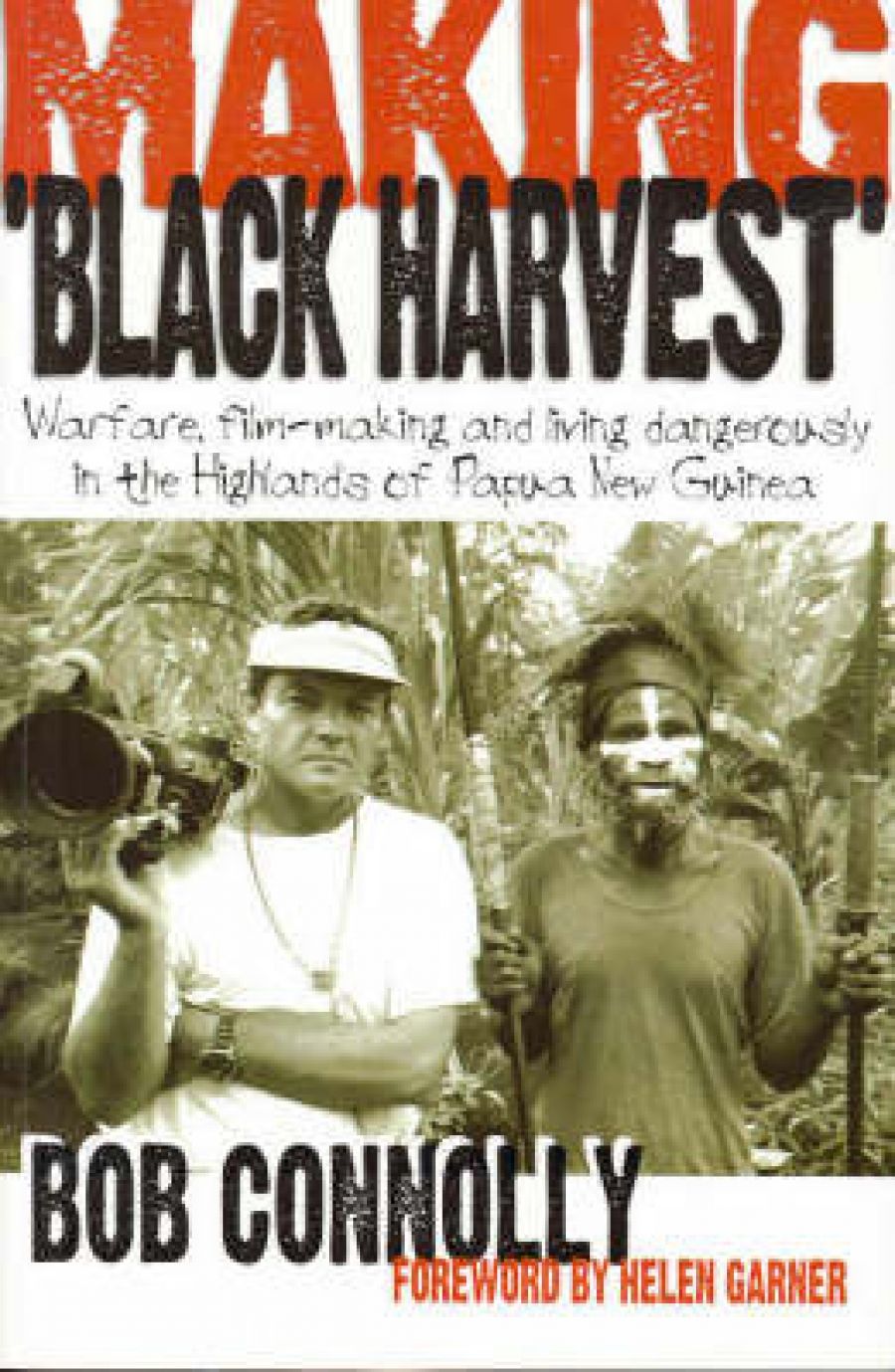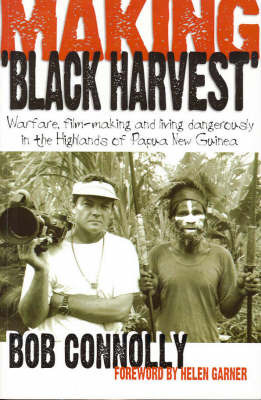
- Free Article: No
- Contents Category: Non-fiction
- Review Article: Yes
- Article Title: Landing a whopper
- Online Only: No
- Custom Highlight Text:
Bob Connolly and Robin Anderson – partners in life and work – made three documentaries in the Papua New Guinea Highlands: First Contact (1983), Joe Leahy’s Neighbours (1989) and Black Harvest (1992). These films have won several awards which is fitting, given that each exemplifies what is possible in the medium of observational filmmaking, where the drama evolving from real situations outdoes anything that could be imagined in a Hollywood studio. Of course, they were shrewd in their choice of subject. With its mixture of cultures and traditions, PNG offers plenty of conflict, the essential salt in the documentary pie. Anderson and Connolly had a special taste for salt – who else would have recognised local mayoral elections as a site of grand drama as they did for Rats in the Ranks (1996)?
- Book 1 Title: Making ‘Black Harvest’
- Book 1 Subtitle: Warfare, filmmaking and living dangerously in the highlands of Papua New Guinea
- Book 1 Biblio: ABC Books, $32.95 pb, 303 pp
- Book 1 Cover Small (400 x 600):

- Book 1 Cover (800 x 1200):

In Making ‘Black Harvest’, Connolly reflects on the years he and Anderson spent in PNG and tells the story that will be familiar to viewers of the documentaries (which have been re-released as a DVD box set). Searching for gold in the 1930s, the Australian Leahy brothers made ‘first contact’ with Highlanders and recorded their mutual astonishment on film. The troubled relationship of Michael Leahy’s mixed-race son, Joe, with the Ganiga tribe on whose land he built a coffee plantation is the focus of the next two movies. It comes to a devastating conclusion when the coffee harvest Anderson and Connolly went expecting to film in 1990 collapses amid an outbreak of bloody tribal warfare.
The central players in Joe Leahy’s Neighbours and Black Harvest are the coffee planter precariously straddling two opposing worlds; Popina Mai, the ‘feisty bantam’ undone by naïveté; and the engaging but untrustworthy Joseph Madang. In Making ‘Black Harvest’, these figures are joined by two previously invisible characters, Connolly and Anderson, whose personal story provides a crash course in the practice and ethics of documentary film-making as well as testifying to the tough joys of a relationship built on a shared passion.
The book reveals the patience and perceptiveness required to make documentaries their way, along with the huge editorial demands. The accumulated scenes are constantly discussed as they work on what plot line to pull from the disorderly mass of daily existence. The fact that there must be a plot is something about which Connolly is adamant, as he discussed early on during the filming of Black Harvest: ‘Above all else film has to be a narrative … We have to say something about human character, not give lessons in anthropology, human economy etc. What is the story? We don’t know yet!’
You don’t need to be a film-maker to share Connolly’s excitement at capturing scenes that make this story – ‘like a trout fisherman landing a whopper’ – nor his frustration at missing priceless opportunities. Paradoxically, their professional elation is strongest when filming the scenes that show the greatest personal tragedy. Connolly, aware that a documentary’s success often rests on the misery of its subjects, compares them to ‘a pair of hovering vultures’. The author is sometimes shocked by the film-maker, at the cold-blooded ambition behind the question ‘Can we film?’, but Connolly remains unapologetic about the cunning required to operate in a society so riven by competing alliances. Such wiliness gains them access to informants and then, as the warfare intensifies, keeps them alive. Equally important is a sense of humour: how else could you bear being testified to by the reborn raskol Big Bad Bants (who then asks for a loan), or having the man you employ to dig your toilet stop halfway and run off with a pair of your shoes?
Despite their professional commitment to neutrality, the book makes clear it was impossible to remain uninvolved. Anderson and Connolly contribute money and medicine, but even more significant are the emotional ties: they feel great sympathy for the players in this Greek tragedy; guilt about their insider knowledge; anger at the waste of lives and crops; grief as the warfare fells their friends. One of the most poignant scenes in the book describes Connolly’s return to ‘his subjects’ after attending his father’s funeral in Australia, welcomed in an embrace by men who affirm and share his tears.
This scene is echoed in the Postscript to Making ‘Black Harvest’. After Robin Anderson died of cancer in 2002, Connolly speaks on the phone to a tearful Joe and Popina, reconnected again. This is a book that perhaps was only written because of Anderson’s death, and it is hers, too. Connolly makes extensive use of the diary she kept while making the film, and her character leaps off the page: brave, quick-witted, determined, compassionate but never sentimental, and blessed with a dogged humour. This is Connolly’s description of their resolution with a violent blackmailer:
Madang, Tepra and Wanis went off into a huddle. ‘We have reached an agreement,’ said Madang. ‘You give him 200 kina, he’ll give you a small pig, and the matter will be settled.’
‘How small?’ said Robin and everyone fell about laughing.
Reading of the warfare, assassinations and arson, you might wonder about the wisdom of taking a two-year-old along for the ride. But then, looking at Katherine’s beaming and delighted face in the photographs, it is clear what an adventure it was. Making Black Harvest was simply enormous fun.


Comments powered by CComment